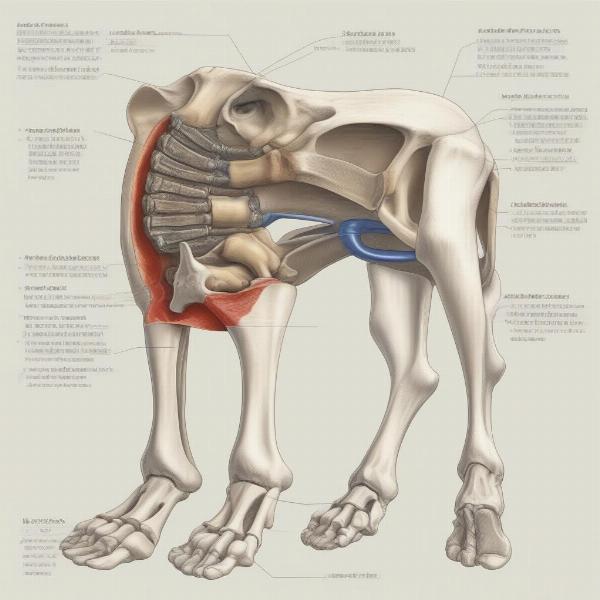The hock of a dog, often mistaken for the ankle, is a crucial part of their hind leg anatomy, playing a vital role in their movement and overall well-being. Understanding its structure and function can help owners recognize potential problems and provide appropriate care. This article will delve into the intricacies of the canine hock, covering everything from its anatomical makeup to common injuries and preventative measures.
Anatomy of the Canine Hock
The hock joint, technically known as the tarsal joint, is a complex structure comprised of multiple bones, ligaments, and tendons. It connects the lower leg bones (tibia and fibula) to the metatarsals of the paw. This joint allows for a wide range of motion, enabling dogs to run, jump, and navigate various terrains. The prominent point of the hock is actually the calcaneus, equivalent to our heel bone.
 Dog Hock Anatomy Diagram
Dog Hock Anatomy Diagram
The intricate network of ligaments and tendons within the hock provides stability and facilitates movement. These strong, fibrous tissues work together to control the joint’s flexion and extension, allowing for smooth, controlled motion.
Common Hock Injuries in Dogs
Due to its role in supporting weight and facilitating movement, the hock is susceptible to various injuries. Some common hock problems include:
- Hyperextension: This occurs when the hock is bent too far forward, potentially damaging ligaments.
- Sprains and Strains: Overexertion or sudden twisting can lead to sprains (ligament damage) and strains (tendon or muscle damage).
- Arthritis: Degenerative joint disease can affect the hock, causing pain, stiffness, and reduced mobility.
- Fractures: Trauma can result in fractures of the bones within the hock joint.
Recognizing the signs of hock injuries is crucial for early intervention. Lameness, swelling, pain on palpation, and reluctance to bear weight on the affected leg are all indicators of a potential problem.
Preventing Hock Injuries
While not all hock injuries are preventable, proactive measures can significantly reduce the risk. Maintaining a healthy weight for your dog can minimize stress on the joints. Regular, moderate exercise helps strengthen supporting muscles and maintain joint flexibility. Avoid activities that place excessive strain on the hock, such as repetitive jumping or high-impact sports. shock collar barking dog
Providing a supportive and comfortable resting area can also contribute to hock health, particularly for older dogs or breeds predisposed to joint issues.
Seeking Veterinary Care
If you suspect your dog has a hock injury, prompt veterinary attention is essential. Early diagnosis and treatment can improve the chances of a full recovery and minimize long-term complications. Your veterinarian will conduct a thorough examination, possibly including X-rays or other imaging techniques, to determine the nature and extent of the injury. Treatment options may include rest, medication, physical therapy, or in some cases, surgery.
Conclusion
The hock is a complex and vital joint in a dog’s hind leg. Understanding its anatomy, common injuries, and preventative measures is key to ensuring your canine companion’s mobility and well-being. By being proactive and attentive to your dog’s health, you can help protect their hocks and keep them active and happy for years to come.
FAQ
-
What is the difference between a dog’s hock and ankle? The hock is equivalent to the human ankle, while the dog’s wrist is analogous to our wrist.
-
What are the signs of arthritis in a dog’s hock? Stiffness, lameness, swelling, and decreased activity are common signs of hock arthritis.
-
Can hock injuries be treated at home? No, always consult a veterinarian for diagnosis and treatment of any suspected hock injury.
-
How can I prevent hock injuries in my dog? Maintaining a healthy weight, providing regular exercise, and avoiding high-impact activities can help prevent hock injuries.
-
What is the prognosis for dogs with hock injuries? The prognosis varies depending on the severity and type of injury. Early intervention generally leads to better outcomes.
-
Are certain dog breeds more prone to hock problems? Yes, some breeds like German Shepherds and Rottweilers are more susceptible to certain hock conditions.
-
What does hyperextension of the hock look like? The hock joint will appear to be bent too far forward.
ILM Dog is a leading international online resource for dog owners, offering expert advice on all aspects of canine care and wellbeing. From breed selection and health to training, nutrition, grooming, and exercise, we’re dedicated to providing valuable, practical information to help you provide the best possible care for your furry friend. We also offer guidance on puppy care, senior dog care, and traveling with your dog, as well as reviews and recommendations for dog products and accessories. For professional guidance tailored to your dog’s specific needs, reach out to us. Email: [email protected] Phone: +44 20-3965-8624. ILM Dog is here to support you and your canine companion on every step of your journey together!